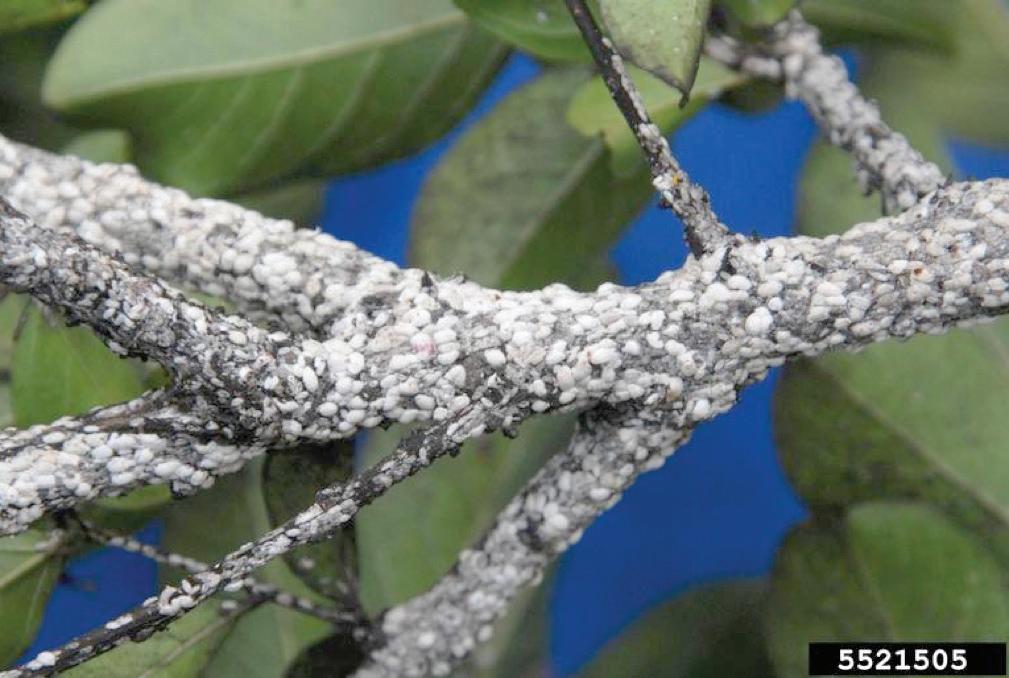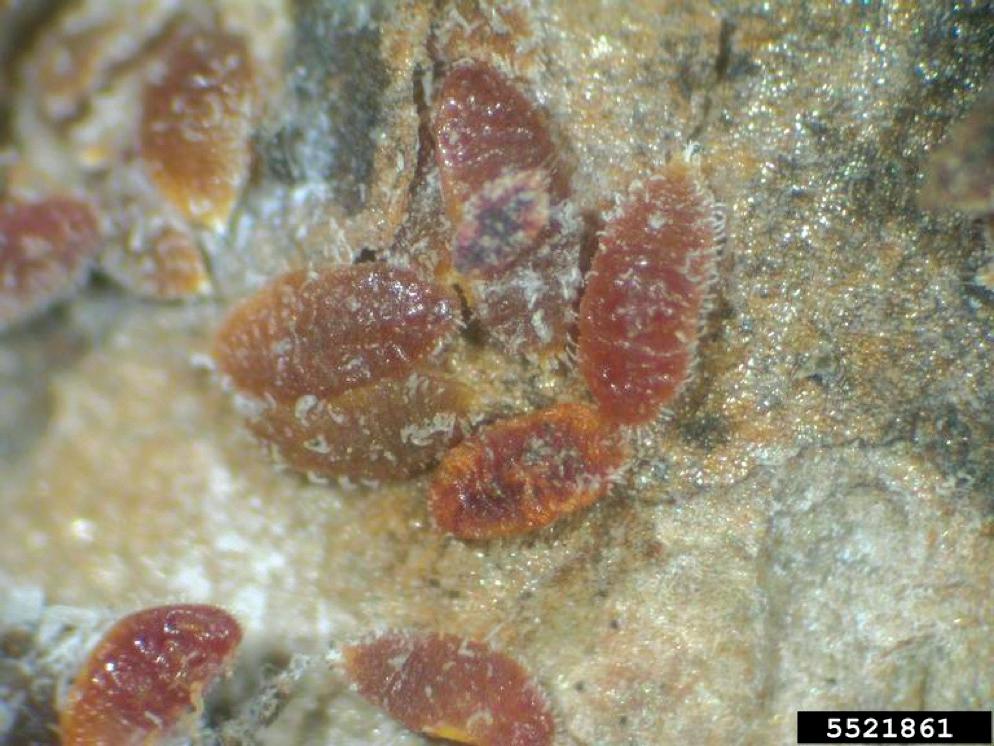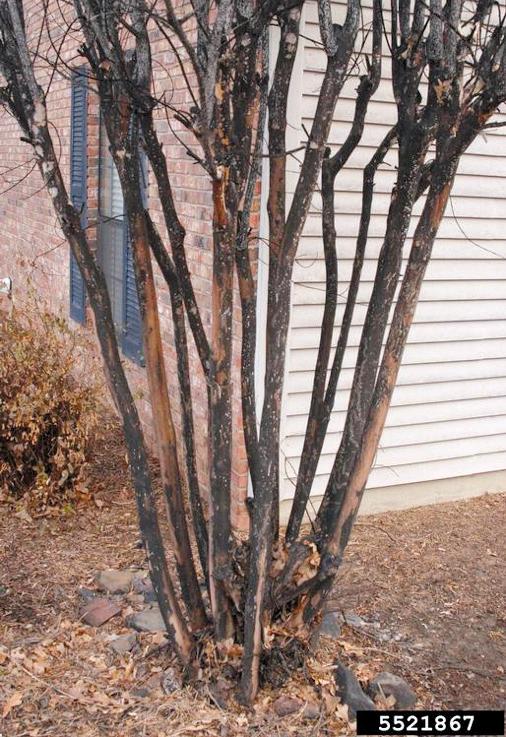
4 minute read
Pest 411 Crapemyrtle bark scale
Crapemyrtle bark scale
Emerging invasive pest
by Shimat V. Joseph, Department of Entomology, University of Georgia
Photo: Jim Robbins, Univ. of Ark. CES, Bugwood.org Fig. 1. Crapemyrtle bark scale infestation on crapemyrtle.
The crapemyrtle bark scale, Acanthococcus
lagerstroemiae (Fig. 1) is an emerging threat to crapemyrtle (Lagerstroemia spp.) in Georgia. As the name indicates, this scale pest attacks the bark of crapemyrtle, the only known scale to do so. This scale, a native to Asia, was first confirmed in Dallas, Texas, in 2004. Since then, this pest has gradually expanded its range to the southeastern states. In Georgia, it was first confirmed in Coweta County in 2014. In 2019, they were found infested in an ornamental nursery in south Georgia. They can potentially spread in zone 6 to 9.
Biology
The crapemyrtle bark scale has three life stages: eggs, nymphs, and adults. Females lay eggs in white or gray felt-like eggsac or ovisac. A female can lay up to 100-300 eggs. Within a week, the eggs hatch and the first instars (earliest nymphal stage) typically referred to as crawlers emerge from the eggsacs. Crawlers have appendages such as legs and antennae and are the only mobile stage of this scale insect. Crawlers prefer the cracks and crevices on the bark, and the infestation begins when the crawlers settle on the bark. Once they settle, they put out their elongated tube-like mouthpart into the stem, access the phloem vessels, and begin to suck up the plant nutrients. The settled crawlers lose all the appendages as soon as they molt into the second nymphal stage. The nymphs are typically pinkish in color (Fig. 2). During the season, the scale population grows and pretty much covers the entire crapemyrtle bark. They complete a life cycle within 2-3 months; there could be 2-3 generations per year. The nymphs, primarily second instars, are the overwintering stage of this scale pest.
Damage
Almost all life stages, from crawlers to gravid females, can activity feed on crapemyrtle and cause serious damage. The infested trees can appear severely stunted, with dieback symptoms on the branches. With a severe infestation, the entire tree can die off.
When nymphs and females insert their strawlike, piercing and sucking mouthparts into the phloem, they suck up more sugars than they need, and the excess sugars are excreted as excrements referred to as honeydew. Because this scale insect profusely produces honeydew, sooty mold fungus readily develops on the honeydew, and thus, the infested bark appears black in color (Fig. 3). However, sometimes sooty mold fungus develops on the leaves which may not be caused by crapemyrtle bark scale but instead caused by crapemyrtle aphid. If you find a red liquid (hemolymph) ooze out from the crushed scales especially when you rub the scales attached to the bark with your fingers, it most likely to be crapemyrtle bark scale.
Host range
Crapemyrtle is the most preferred host for crapemyrtle bark scale. Other potential hosts are American beautyberry (Callicarpa americana),
henna (Lawsonia inermis), axlewood (Anogeissus latifolia), Korean Boxwood (Buxus microphylla), pomegranate (Puica granatus), native sinicuichi (Heimia salicifolia) and winged loosestrife (Lythrum alatum).
Monitoring and management
Regular inspection of the tree bark will be necessary to detect the problem early. Doublesided tape can be wrapped around the branches to determine crawler activity (gravid females and older nymphs will not be trapped on the tape). In the Gulf states, the first peak of crawler activity is typically noticed in mid-May and the second peak in mid-October. The exact seasonal development of the scale can vary by the local temperature.
As cultural management, pruning the side branches with infestations may reduce the population size. Several predators, mostly ladybugs (Chilocorus stigma, Hyperaspis bigminata, Harmonia axyridis, and Scymnus sp) naturally occur in the landscape and nursery, and they attack the scales and reduce the population to a certain level. Because the population of this scale pest can build up quite rapidly in the summer months, the scales can outnumber the predators. During the early stages of infestation, physically removing the scales using a brush may temporarily help but is less likely to provide long-lasting control. Ants can be observed on the infested crapemyrtle bark, but it is not clear if they function as a predator or instead tend the scales for honeydew.
For longer-term control, the use of insecticides is necessary. Systemic insecticide such as neonicotinoids (imidacloprid, dinotefuran, clothianidin) applied as a soil drench have proven effective. However, these systemic insecticides, especially imidacloprid, can be harmful to foraging pollinators. Insect growth regulators (e.g., pyriproxyfen) have provided effective control if applied when the crawlers are active. The crawlers are devoid of the waxy coating that protects older nymphs and adults. Horticultural oils have provided inconsistent control and are generally ineffective if not applied during peak crawler emergence window in the spring (April or May). Fig. 2. Crapemyrtle bark scale nymphs.

Jim Robbins, Univ. of Ark. CES, Bugwood.org

Jim Robbins, Univ. of Ark. CES, Bugwood.org Fig. 3. Sooty mold on the bark of crape myrtle.
Carefully read the insecticide label, including the precautionary statements before applying any insecticides. The insecticide label is the law.










